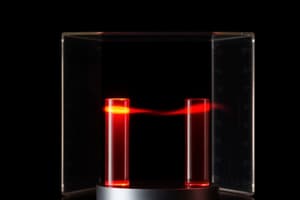Podcast
Questions and Answers
What indicates that two systems are in thermal equilibrium?
What indicates that two systems are in thermal equilibrium?
Two systems are in thermal equilibrium when they exchange no thermal energy with each other, resulting in constant temperatures.
Explain the relationship between pressure and volume in a gas as described by Boyle's law.
Explain the relationship between pressure and volume in a gas as described by Boyle's law.
Boyle's law states that for a given amount of gas at constant temperature, pressure and volume are inversely related; as one increases, the other decreases.
Define equilibrium state in the context of thermodynamic systems.
Define equilibrium state in the context of thermodynamic systems.
An equilibrium state occurs when the system's independent coordinates are constant, meaning there's no net change in the system under unchanging external conditions.
What role do boundaries play in the equilibrium of thermodynamic systems?
What role do boundaries play in the equilibrium of thermodynamic systems?
How do generalized coordinates X and Y relate to a thermodynamic system's description?
How do generalized coordinates X and Y relate to a thermodynamic system's description?
Why is temperature considered an essential variable in thermodynamic systems?
Why is temperature considered an essential variable in thermodynamic systems?
What is the significance of keeping mass and composition constant in analyzing gaseous systems?
What is the significance of keeping mass and composition constant in analyzing gaseous systems?
Describe the implications of having independent coordinates in a system of constant mass.
Describe the implications of having independent coordinates in a system of constant mass.
What is the significance of an adiabatic wall in thermodynamics?
What is the significance of an adiabatic wall in thermodynamics?
List two materials that can serve as good experimental approximations to ideal adiabatic walls.
List two materials that can serve as good experimental approximations to ideal adiabatic walls.
How does macroscopic thermodynamics differ from microscopic models in studying matter?
How does macroscopic thermodynamics differ from microscopic models in studying matter?
What two types of energy are considered in the mechanics of a rigid body?
What two types of energy are considered in the mechanics of a rigid body?
Define what is meant by mechanical coordinates in the context of classical mechanics.
Define what is meant by mechanical coordinates in the context of classical mechanics.
Why is thermodynamics considered to have not been disproven despite advancements in statistical mechanics?
Why is thermodynamics considered to have not been disproven despite advancements in statistical mechanics?
In thermodynamics, what is the primary focus when studying systems?
In thermodynamics, what is the primary focus when studying systems?
What is one of the historical starting points for investigations in natural sciences according to the document?
What is one of the historical starting points for investigations in natural sciences according to the document?
Flashcards
Adiabatic Wall
Adiabatic Wall
A wall that prevents the transfer of heat between systems.
Equilibrium State
Equilibrium State
A state where a system's properties do not change with time.
Macroscopic Description
Macroscopic Description
System description based on large-scale measurable properties.
Mechanical Coordinates
Mechanical Coordinates
Signup and view all the flashcards
Macroscopic Point of View
Macroscopic Point of View
Signup and view all the flashcards
Thermodynamics
Thermodynamics
Signup and view all the flashcards
Statistical Mechanics
Statistical Mechanics
Signup and view all the flashcards
External Energy
External Energy
Signup and view all the flashcards
Independent Coordinates
Independent Coordinates
Signup and view all the flashcards
Generalized Force (X)
Generalized Force (X)
Signup and view all the flashcards
Generalized Displacement (Y)
Generalized Displacement (Y)
Signup and view all the flashcards
Diathermic Wall
Diathermic Wall
Signup and view all the flashcards
Thermodynamic System
Thermodynamic System
Signup and view all the flashcards
Equilibrium Dependence
Equilibrium Dependence
Signup and view all the flashcards
Study Notes
Thermal Equilibrium and the Zeroth Law
- Macroscopic description of a gaseous mixture involves composition, mass, pressure, volume, and temperature.
- Pressure and volume are independent coordinates related by Boyle's law.
- Tension and length are independent coordinates for a wire.
- Surface tension and area are independent for a surface film.
- Some complex systems (like cells with electrodes and electrolytes) can be described with a few independent coordinates.
- Systems with multiple homogeneous parts require independent coordinates for each part.
Equilibrium State
- Equilibrium state: A system's coordinates (X and Y) have constant values while external conditions remain unchanged.
- Equilibrium state depends on neighboring systems and boundary walls (adiabatic or diathermic)
- Adiabatic walls: Ideal walls resisting stress from differing coordinates (e.g., wood, concrete, dewar flasks).
- Diathermic walls: Walls allowing transfer of heat.
Macroscopic Viewpoint in Thermodynamics
- Thermodynamics searches for laws and relationships to understand macroscopic temperature-dependent phenomena.
- It doesn't rely on microscopic structure, unlike statistical mechanics (hence, not disproven by microscopic models).
- Macroscopic description uses measurable properties like position, time, velocity (mechanical coordinates) to understand macroscopic aspects of objects (e.g. kinetic and potential energy).
Studying That Suits You
Use AI to generate personalized quizzes and flashcards to suit your learning preferences.




